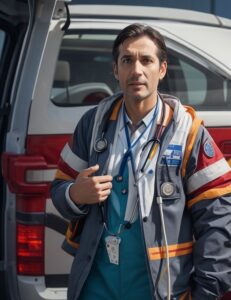The Interstate Medical Personnel System, or EMC, is a comprehensive framework that enables medical professionals to provide their services across state lines during emergencies. This system allows healthcare workers to travel to areas affected by disasters or pandemics and offer their expertise where it is needed the most. EMC creates a pool of qualified medical personnel who can be deployed swiftly to areas facing healthcare shortages during emergencies.
Policies and Protocols
Licensing and Credentialing
When healthcare professionals mobilize to assist in emergency situations across state lines, waiting for lengthy licensing procedures simply isn’t an option. EMC eliminates these delays. It ensures that doctors, nurses, and other medical experts can swiftly obtain temporary licenses, granting them the legal authority to practice in the affected area.
A physician from one state can seamlessly offer medical care in another state without the burdensome bureaucratic hurdles. It’s a testament to the adaptability and responsiveness of the healthcare system, enabling professionals to be where they are needed most urgently.
While licensing grants legal permission, credentialing verifies expertise. It’s the meticulous process of evaluating a healthcare professional’s qualifications, skills, and experience. Hospitals, emergency response teams, and medical facilities need to ensure that the professionals they are bringing in possess the skills necessary to handle the unique challenges of emergency situations.
Credentialing acts as a filter, ensuring that only the most qualified individuals are entrusted with the critical task of saving lives. Patients and medical teams alike can rest assured that the person providing care is not only legally permitted but also exceptionally qualified.
Behind the bureaucratic terminologies and procedural formalities, there’s a deeply human aspect to licensing and credentialing. Consider the confidence that surges through a community when they know that the medical professionals arriving to assist are not just legal entities but skilled, verified experts.
These processes provide a sense of order amidst chaos, assuring both medical professionals and the people they serve that the right hands are on deck.
Coordination with Local Authorities
When a community copes with the effects of a natural disaster, local medical facilities are overwhelmed and there is an urgent need for additional medical support. This is where the coordination with local authorities steps in as the linchpin of effective emergency response.
Local authorities provide essential information to out-of-state medical teams, ensuring that resources are allocated where they are most needed. It’s a partnership where every piece of information shared is a step towards efficient and targeted care.
Coordination with local authorities establishes clear channels of communication. These channels enable medical teams to understand the local landscape, the specific needs of the community, and any unique challenges posed by the emergency at hand.
This brings reassurance to a worried parent awaiting medical assistance for their child or an elderly person in need of urgent medical attention. Clear communication ensures that help arrives where it’s needed, when it’s needed, bringing hope and relief to those facing the daunting challenges of an emergency.
Efficient coordination ensures that resources are optimized to their fullest potential. Medical supplies, personnel, and facilities are directed to areas where they can make the most significant impact. This precision in resource allocation isn’t just a logistical achievement. I t’s a testament to the dedication of both out-of-state medical teams and local authorities in ensuring that every second counts in the race to save lives.
 Liability and Insurance Coverage
Liability and Insurance Coverage
Emergencies bring forth a multitude of challenges, not the least of which are legal complexities. Healthcare professionals, even when acting in the service of saving lives, face the risk of legal liabilities. Liability protection ensures that these individuals can make crucial decisions swiftly, without the constant fear of legal repercussions.
Liability protection allows doctors to focus entirely on the patient, knowing that their decisions are protected under the law. This protection is an assurance that their dedication will not be met with unwarranted legal challenges.
Insurance coverage steps in as the safety net, providing a financial shield for healthcare professionals. It ensures that in the unfortunate event of legal claims or unforeseen circumstances, professionals are not burdened with overwhelming financial responsibilities.
In emergency medical response, insurance coverage ensures that these professionals can focus on their vital tasks, knowing that their financial security is safeguarded.
Crisis-Specific Protocols
The implementation of crisis-specific are meticulously crafted guidelines tailored for specific types of emergencies. They outline the best practices, procedures, and strategies that have proven to be effective in similar situations in the past. This specificity is a requirement, ensuring that healthcare professionals are well-prepared to handle the unique challenges posed by each crisis.
Crisis-specific protocols describe methods for rapid triage, efficient allocation of resources, and specialized treatments tailored to disaster-related trauma, from organizing mass evacuations to providing first aid in challenging environments.
Pandemics bring a different set of challenges – infectious diseases spreading rapidly, overwhelming healthcare systems, and the need for extensive testing and contact tracing. Crisis-specific protocols for pandemics focus on containment and mitigation strategies. They outline procedures for testing, isolation, treatment, and vaccine distribution. They emphasize communication strategies to educate the public, dispel myths, and foster a sense of community responsibility.
Crisis-specific protocols for industrial accidents focus on decontamination procedures, specialized medical treatments for chemical exposure, and strategies for managing large-scale casualties. These protocols encompass collaboration with environmental agencies, local authorities, and industrial experts to mitigate the impact of the accident effectively.
These protocols ensure that every action taken is backed by research, expertise, and collective wisdom accumulated from past experiences.
During emergencies, every minute counts, and having a system that allows skilled medical professionals to reach patients promptly can mean the difference between life and death. Families torn apart by disasters find solace in the presence of healthcare workers, and communities ravaged by pandemics gain hope through the expertise of these dedicated individuals.
